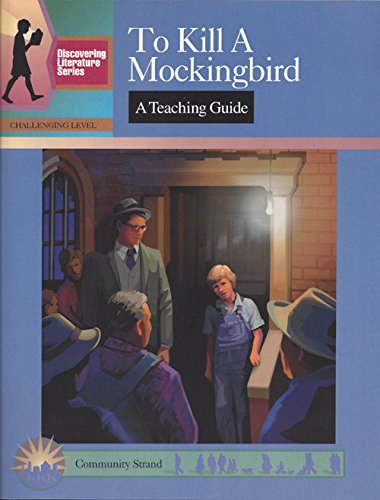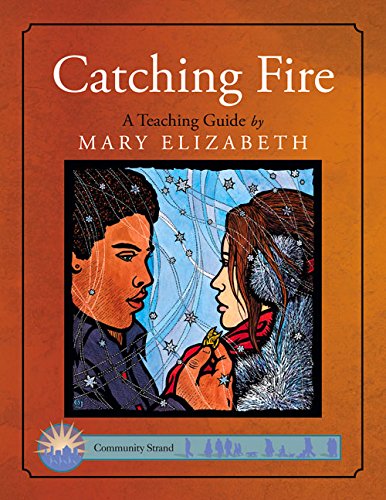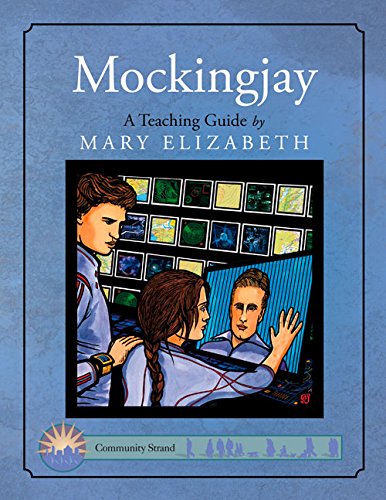Age
12+
Grade
7+
Mary Elizabeth, Kathy Kifer
To Kill a Mockingbird: A Teaching Guide
Paperback
(Garlic Press April 1, 2002)
, Teaching Guide ed. edition
The challenging level focuses on a variety of reading strategies to help students construct a meaningful literature experience as well as develop critical thinking and academic skills.
Table of Contents
Notes to the Teacher
About the Organization of This Literature Guide
o Chapter Pages
o Strategy Pages
o Tests
o Writer s Forum Pages
o History of Social Thought Pages
o Theme Pages
The Groupings of Literature
Introducing the Literature
Sample Lesson Plan
Quick Find Legal Vocabulary
Book Order
Alphabetical Order
Quick Find Chapter Index
Bibliography
Note: The chapters in this book are untitled: the phrases after each title are placed as guides
Part One:
Strategy 1: Beginning a Book
Strategy 2: Marking a Text
Chapter 1: Dill Arrives
Strategy 3: References and Allusions Consulting Outside Sources
Strategy 4: Plot The Design of a Story
Strategy 5: Forming Hypotheses
Strategy 6: Rhetorical Figures
Chapter 2: Scout s First Day of School
Strategy 7: Characterization
Writer s Forum 1: Description
Strategy 8: Plot Conflict
Writer s Forum 2: Journal
Chapter 3: Walter Cunningham and Burris Ewell
Strategy 9: Irony
Strategy 10: Point of View
Writer s Forum 3: Compare and Contrast Essay
Chapter 4: Gum in the Oak Tree
Strategy 11: Setting and Mood
Strategy 12: Foreshadowing and Flashback
Chapter 5: Miss Maudie; The Fishing Pole Note
Strategy 13: Dialogue
Writer s Forum 4: Dialogue
Test 1: Chapters 1-5
Chapter 6: Jem Loses His Pants...and Recovers them
Writer s Forum 5: Persuasion
Chapter 7: Soap Figures; Thank you; Filing the Knot-Hole
Writer s Forum 6: Thank-you Note
Chapter 8: Snow and Fire
Writer s Forum 7: Parody
Chapter 9: Atticus Accepts the Robinson Case; Scout Fights Francis
Strategy 14: Names and Characterizating Terms
Chapter 10: Mad Dog
Strategy 15: Characterization Continuum
Chapter 11: Mrs. Dubose
Writer s Forum 8: Definition
Test 2: Chapters 6-11
Part Two
Chapter 12: Calpurnia s Church
Strategy 16: Prior Knowledge
Chapter 13: Aunt Alexandra Comes to Stay
Strategy 17: Distinguishing Fact and Opinion
Chapter 14: Dill Runs Away
Chapter 15: Friends in the Yard; Mob at the Jail
Strategy 18: Historical Fiction/Autobiography
Test 3: Chapters 12-15
Chapter 16: The Courtroom
Chapter 17: Heck Tate and Robert E. Lee Ewell Testify
Strategy 19: Sensory Language
Chapter 18: Mayella Ewell Testifies
Strategy 20: Imaging
Chapter 19: Tom Robinson Testifies
Chapter 20: Dill and Mr. Dolphus Raymond Meet; Atticus s Closing Speech
Strategy 21: Revising Hypotheses
Chapter 21: The Jury Decides
Writer s Forum 9: News Article
Test 4: Chapters 16-21
Chapter 22: Reactions to the Verdict; Bob Ewell Threatens Atticus
Chapter 23: Picking the Jury in Retrospect; Folks
Writer s Forum 10: Summary
Chapter 24: Missionary Circle Meeting
Strategy 22: Stock Characters and Character Foils
Chapter 25: The Death of Tom Robinson
Writer s Forum 11: Eulogy/Anecdote
Chapter 26: Hitler and Democracy
Test 5: Chapters 22-26
Chapter 27: Bob Ewell Trespasses at Judge Taylor s, Trails Helen
Writer s Forum 12: Possible Ending
Chapter 28: Halloween Pageant and Return Home
Strategy 23: Adjusting Reading Rate
Chapter 29: Scout Tells Her Story and Meets Boo
Strategy 24: Logical Fallacies
Chapter 30: Heck Tate Decides
Writer s Forum 13: Evaluation
Chapter 31: Scout Takes Boo Home; Last View of the Finch Family
Table of Contents
Notes to the Teacher
About the Organization of This Literature Guide
o Chapter Pages
o Strategy Pages
o Tests
o Writer s Forum Pages
o History of Social Thought Pages
o Theme Pages
The Groupings of Literature
Introducing the Literature
Sample Lesson Plan
Quick Find Legal Vocabulary
Book Order
Alphabetical Order
Quick Find Chapter Index
Bibliography
Note: The chapters in this book are untitled: the phrases after each title are placed as guides
Part One:
Strategy 1: Beginning a Book
Strategy 2: Marking a Text
Chapter 1: Dill Arrives
Strategy 3: References and Allusions Consulting Outside Sources
Strategy 4: Plot The Design of a Story
Strategy 5: Forming Hypotheses
Strategy 6: Rhetorical Figures
Chapter 2: Scout s First Day of School
Strategy 7: Characterization
Writer s Forum 1: Description
Strategy 8: Plot Conflict
Writer s Forum 2: Journal
Chapter 3: Walter Cunningham and Burris Ewell
Strategy 9: Irony
Strategy 10: Point of View
Writer s Forum 3: Compare and Contrast Essay
Chapter 4: Gum in the Oak Tree
Strategy 11: Setting and Mood
Strategy 12: Foreshadowing and Flashback
Chapter 5: Miss Maudie; The Fishing Pole Note
Strategy 13: Dialogue
Writer s Forum 4: Dialogue
Test 1: Chapters 1-5
Chapter 6: Jem Loses His Pants...and Recovers them
Writer s Forum 5: Persuasion
Chapter 7: Soap Figures; Thank you; Filing the Knot-Hole
Writer s Forum 6: Thank-you Note
Chapter 8: Snow and Fire
Writer s Forum 7: Parody
Chapter 9: Atticus Accepts the Robinson Case; Scout Fights Francis
Strategy 14: Names and Characterizating Terms
Chapter 10: Mad Dog
Strategy 15: Characterization Continuum
Chapter 11: Mrs. Dubose
Writer s Forum 8: Definition
Test 2: Chapters 6-11
Part Two
Chapter 12: Calpurnia s Church
Strategy 16: Prior Knowledge
Chapter 13: Aunt Alexandra Comes to Stay
Strategy 17: Distinguishing Fact and Opinion
Chapter 14: Dill Runs Away
Chapter 15: Friends in the Yard; Mob at the Jail
Strategy 18: Historical Fiction/Autobiography
Test 3: Chapters 12-15
Chapter 16: The Courtroom
Chapter 17: Heck Tate and Robert E. Lee Ewell Testify
Strategy 19: Sensory Language
Chapter 18: Mayella Ewell Testifies
Strategy 20: Imaging
Chapter 19: Tom Robinson Testifies
Chapter 20: Dill and Mr. Dolphus Raymond Meet; Atticus s Closing Speech
Strategy 21: Revising Hypotheses
Chapter 21: The Jury Decides
Writer s Forum 9: News Article
Test 4: Chapters 16-21
Chapter 22: Reactions to the Verdict; Bob Ewell Threatens Atticus
Chapter 23: Picking the Jury in Retrospect; Folks
Writer s Forum 10: Summary
Chapter 24: Missionary Circle Meeting
Strategy 22: Stock Characters and Character Foils
Chapter 25: The Death of Tom Robinson
Writer s Forum 11: Eulogy/Anecdote
Chapter 26: Hitler and Democracy
Test 5: Chapters 22-26
Chapter 27: Bob Ewell Trespasses at Judge Taylor s, Trails Helen
Writer s Forum 12: Possible Ending
Chapter 28: Halloween Pageant and Return Home
Strategy 23: Adjusting Reading Rate
Chapter 29: Scout Tells Her Story and Meets Boo
Strategy 24: Logical Fallacies
Chapter 30: Heck Tate Decides
Writer s Forum 13: Evaluation
Chapter 31: Scout Takes Boo Home; Last View of the Finch Family
- Series
- Discovering Literature Series: Challengi
- ISBN
- 0931993741 / 9780931993749
- Pages
- 208
- Weight
- 7.2 oz.
- Dimensions
- 8.5 x 0.5 in.
Enjoy reading To Kill a Mockingbird: A Teaching Guide? You may also like these books


